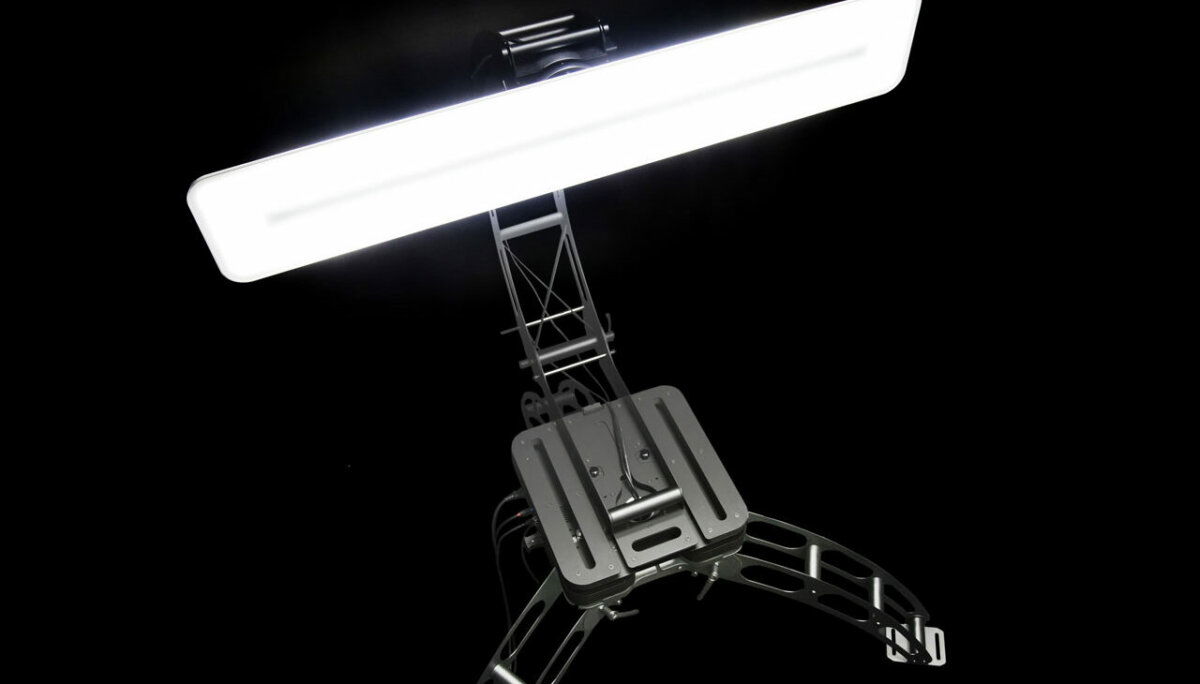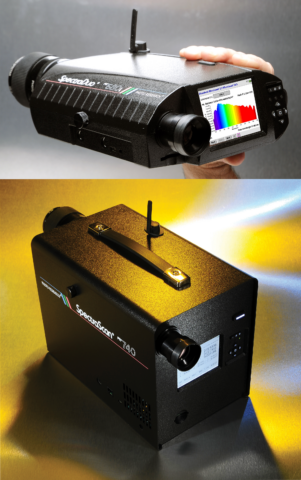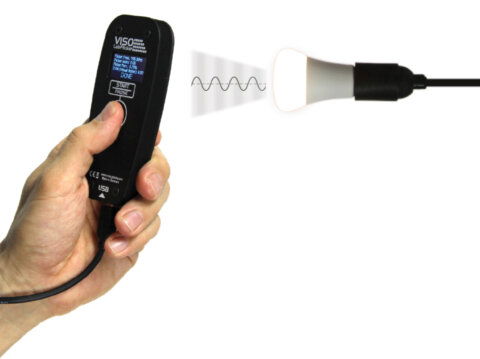Goniophotometer and Spectroradiometers
Light Measurement Technology
We offer high-quality goniophotometers, more precisely goniospectrometers from Viso Systems, as well as spectroradiometers from Photo Research. These technologies enable precise and reliable measurements in light measurement technology.
Goniophotometers, or rather goniospectrometers, are used to determine the light distribution curve, luminous flux, as well as color coordinates and color temperature of light sources.
They capture the spatial light distribution, providing essential data for lighting design and product development.
Spectroradiometers, on the other hand, measure the spectral intensity distribution of light and determine luminance, spectrum, and chromaticity coordinates. They are indispensable for precise spectral analyses in research, development, and quality assurance.

Goniophotometer & goniospectrometer FAQ: all about measurement methods and applications
FAQs Goniophotometer
A goniophotometer rotates the light source (or sensor) around precise axes and records luminous intensity at many angles under far-field conditions. By stitching these angular measurements together, it reconstructs the full 3D light distribution and derives beam angles, peak candela, and total lumen. Modern systems also capture spectral/color metrics (CCT, CRI/TM-30, chromaticity) and electrical data in the same scan, then export standard simulation files (IES/EULUMDAT) and reports for design and compliance work.
Here we explain for you how a goniophotometers works step-by-step (LabSpion example):
1. Far-field setup: The sensor is placed at least 8× the largest luminous dimension of the DUT (device under test) to ensure far-field conditions and accurate angular measurements. A laser range finder helps set this distance automatically.
2. Mount & align the luminaire: The DUT is centered on the goniometer’s rotation axis (Type-C geometry). Alignment tools (mirror/laser) ensure the sensor points exactly at the optical axis/photometric center.
3. Angular scanning: A 2-axis goniometer performs continuous (not stepped) rotation to capture C-planes rapidly (e.g., ~30–60 s per plane depending on resolution). This builds the full 3D intensity pattern.
4. Sensing & spectra: A spectrometer-based sensor records not only intensity (cd) but also spectral data—enabling lumen, CCT, CRI/TM-30, chromaticity, color-over-angle, and more in a single run (often removing the need for an integrating sphere).
5. Power & ambient handling: A built-in power analyzer logs electrical input while an ambient-light correction routine can switch the lamp off briefly to subtract background.
6. Processing & outputs: Software (e.g., Viso Light Inspector) controls the scan and exports IES/LDT, PDF, PNG, CSV/XLS and custom reports containing 3D distributions, beam angles, and photometric/color metrics.
A goniophotometer is a measuring device used to determine the light distribution of luminaires, lamps, and LED modules. It measures luminous intensity distribution, luminous flux, and other photometric properties to evaluate the quality and efficiency of a light source.
Goniophotometry provides detailed data on light distribution, which is essential for lighting design, product development, and luminaire certification. It enables precise evaluation of luminous flux, intensity distribution, and glare values.
Goniophotometers can be categorized in two ways: by their measurement geometry (CIE Type A, B, C) and by their mechanical design (Mirror or Rotating Goniophotometers).
1. Classification by CIE Types
- Type A: The light source remains stationary while the sensor rotates around it. This type is mainly used for directional light sources such as vehicle headlights or projectors.
- Type B: The light source rotates around a vertical axis while the sensor stays stationary. This type is commonly used for streetlights and area floodlights, as these are typically mounted horizontally in practice.
- Type C: The light source rotates around a horizontal axis while the sensor remains stationary. This is the standard for general lighting, such as LEDs, indoor lamps, or incandescent bulbs.
2. Classification by Mechanical Design
- Mirror Goniophotometer: The sensor remains stationary while a mirror reflects the light for measurement. This design allows for compact measurement systems and can shorten measurement time.
- Rotating Goniophotometer: The light source is moved around different axes while the sensor captures the light distribution. This method is often considered more precise as there are no mirror losses.
The choice of the appropriate goniophotometer depends on the specific application. While the CIE types define how the measurement is performed, the mechanical design affects the efficiency and accuracy of the measurement.
Goniophotometers from Viso Systems can be purchased or ordered directly from Acal BFi. As an official partner, we not only offer high-quality measuring devices but also expert advice to help you find the right goniophotometer for your specific needs.
Whether for laboratory applications, product development, or quality assurance – at Acal BFi, you get precise and reliable measurement technology from Viso Systems, along with comprehensive support and service.
A goniophotometer can measure the following:
- Luminous intensity distribution (cd)
- Total luminous flux (lm)
- Correlated color temperature (CCT)
- Color coordinates in the CIE color space
- Color rendering index (CRI)
- Spectral distribution
These values are crucial for evaluating the photometric properties of a luminaire.
Key standards for goniophotometry include:
- IES LM-79 (for LED luminaires in North America)
- CIE 121 (international standards for goniophotometers)
- EN 13032 (European standard for light measurement)
- IES TM-30 (advanced color measurement methodology)
These standards ensure that measurements are comparable and reproducible. The accuracy of a goniophotometer depends on various factors, including the sensor quality, positioning of the light source, and system calibration. High-precision systems achieve measurement uncertainties of less than 2%.
An integrating sphere is used to measure the total luminous flux of a light source by capturing all emitted light in all directions and distributing it evenly across its inner surface. It provides integrated photometric and spectral data, such as total luminous flux [lm], spectral power distribution, and color characteristics. Integrating spheres are ideal for fast, repeatable measurements of the total light output of LEDs, lamps, and luminaires, especially in laboratory and production environments.
However, a goniospectrometer offers a significant advantage: It not only measures spectral properties like an integrating sphere but also records the luminous intensity distribution. This means that, in addition to total luminous flux, it provides information on the spatial light distribution and spectral variations over angle (Color over Angle). These data are crucial for applications where the emission direction matters, such as spotlights, streetlights, or display backlighting.
For LEDs, precise light distribution measurement is crucial since LEDs produce directional light. Goniophotometry allows for:
- Optimization of lenses and reflectors
- Quality control in production
- Comparison of different LED modules
- Validation of lighting simulations
Accurate measurements ensure that LEDs are used efficiently and in compliance with standards.
A goniophotometer measures the light distribution characteristics of a light source, particularly the luminous intensity distribution (candela distribution) at different angles. It provides photometric data, which are adapted to human visual perception, such as luminous intensity [cd] and luminous flux [lm]. Goniophotometers are commonly used in lighting technology for lamps, luminaires, and vehicle headlights.
A goniospectrometer offers an advantage over a goniophotometer by providing not only photometric data but also spectral information, enabling a more comprehensive analysis of the light source. It measures spectral radiance or spectral intensity, delivering additional insights such as color temperature, spectral composition, and color rendering index. This is particularly beneficial for applications where spectral light quality is crucial, such as LEDs, displays, or specialized lighting solutions.
The advantage of a goniospectrometer lies in its ability to combine both photometric and spectral measurements, allowing for a more detailed evaluation of the light source.



